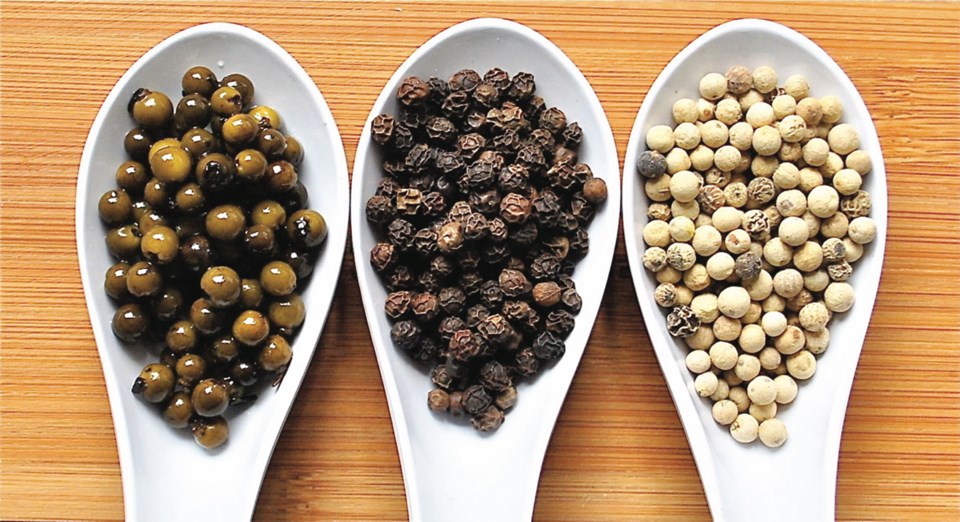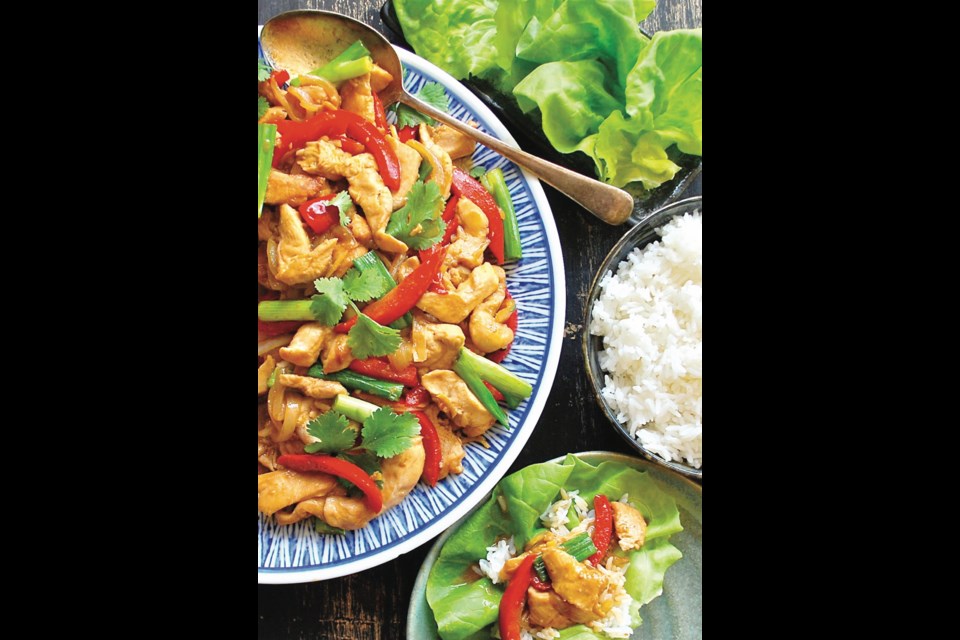A reader asked me what the difference was between black and white peppercorns, and how those differences affect their culinary usage. A good question. And if you, too, are unsure of the answer, read on and, as a bonus, I’ll explain what green peppercorns are.
Peppercorns are a spice that comes from Piper nigrum, the botanical name for a climbing, tropical vine cultivated in places such as India and Southeast Asia. Peppercorns are made by harvesting the plants’ small, pungent berries and drying them.
How ripe those berries are when picked determines what type of peppercorns you get once processed.
For green peppercorns, the berries are harvested when green and underripe. At this point, the still-tender berries have not developed their full, pungent flavour, but instead have milder spicy bite.
Green peppercorns are sold dried, but in supermarkets you’ll most often find them sold in cans and jars packed in brine. They can be used whole or crushed in a wide array of dishes. One popular option is to add them whole to a wine-rich sauce you serve with tender steaks.
Black peppercorns are made from berries harvested when mature in size, but still not completely ripe. When dried, they shrivel and turn dark brown to black in colour and have an earthy, woody, sharp, pungent aroma and taste.
Black peppercorns are sold whole or ground and might be the world’s most popular spice. Folks all over of the world use it daily to flavour all sorts of foods, from eggs to soups, stews to roasts.
White peppercorns are made from fully ripe berries at their spiciest and fruitiest in flavour. After harvesting, the berries are soaked and their outer covering removed. The berries are then dried and the resulting peppercorns that have an off-white colour, hence their name.
White peppercorns are sold whole and are great to use in such things as marinades and brines for meat and poultry, poaching liquids for fish, and pickles.
White peppercorns are also finely ground and sold as a spice called white pepper. Many European/North American chefs like to add white pepper to light coloured preparations, such as mayonnaise, milk- or cream-based sauces, cream soups and other dishes, such as mashed potatoes, because it won’t mar the look of it the way flecks of black pepper would.

White pepper is also used in several Asian cuisines. In Pailin Chongchitnant’s book Hot Thai Kitchen, she writes that white pepper is not used as a tableside seasoning the way black pepper is. Instead, she says, white pepper is often integrated into a dish as an ingredient, adding an essential taste to such things as curries, soups and myriad other creations.
I blended white pepper into the sauce that flavours today’s chicken stir-fry recipe. Because of its intense, full flavour, only a small amount is needed to add a palate-warming taste to it.
Chicken Stir-Fry with Lettuce Wraps
Tender, stir-fried, garlicky slices of chicken, vegetables and a white pepper-spiked sauce can be wrapped up and eaten in lettuce leaves with rice.
Preparation time: 30 minutes, plus marinating time
Cooking time: about 10 minutes
Makes: four servings (see Eric’s options)
2 large garlic cloves, minced
2 Tbsp soy sauce (divided)
1 tsp cornstarch
1 lb boneless skinless chicken breast, cut into 2-inch long, 1/2-inch thick pieces
1/3 to 1/2 cup chicken stock or broth
2 Tbsp oyster sauce
1 tsp sesame oil
2 tsp brown sugar
2 tsp rice vinegar
1/8 to 1/4 tsp ground white pepper (see Note 1)
2 Tbsp vegetable oil, plus more if needed
1 (1 1/2-inch long, about 1-inch wide) piece of fresh ginger, peeled, thinly sliced, and then cut into thin strips
1 small yellow onion, halved and sliced
1 medium red pepper, halved, seed and sliced
3 medium green onions, cut, widthwise, into 1 1/2-inch long pieces
• cilantro sprigs, to taste (optional)
4 cups hot cooked jasmine or long grain white rice, or to taste
1 head butter lettuce, separated into single leaves (see Note 2)
Place garlic, 1 Tbsp soy sauce and cornstarch in a bowl large enough to hold the chicken and whisk to combine. Add the chicken and toss to coat. Cover and let chicken marinate 30 minutes.
Make stir-fry sauce by combining the remaining 1 Tbsp soy sauce, 1/3 cup stock (or broth), oyster sauce, sesame oil, brown sugar, rice vinegar and white pepper in a small bowl.
When chicken has marinated, place 2 Tbsp oil in a wok or large skillet set over medium-high to high heat. Let oil warm a minute or two, until very hot. Add the chicken to the pan (be mindful of splatters) and stir-fry until cooked through, about three to four minutes. Remove pan from the heat. Use tongs to transfer chicken to a plate.
Set the pan back on the heat. Add a bit more oil to the pan, if needed. Place the ginger, onion and red pepper in the pan and stir-fry one to two minutes.
Return chicken to the pan, along with the stir-fry sauce. Cook, stirring occasionally, until sauce simmers, thickens and coats the chicken, about two minutes. Mix in a bit more stock (or broth) if sauce has overly reduced.
Mix in the green onions and then transfer stir-fry to a serving platter. Garnish with cilantro sprigs, if using. Set platter on the dinner table.
To serve, set a bowl of rice and a plate with lettuce leaves on it alongside the stir-fry. Let diners fill their own lettuce leaves with the chicken stir-fry and rice.
Note 1: 1/8 tsp of white pepper will give this stir-fry a mild backbone of that spice. 1/4 tsp will add a bolder bit of heat to the dish.
Note 2: Butter lettuce is sold in plastic tubs in the produce section of most supermarkets.
Eric’s options: If four servings are too many, freeze any leftover stir-fry after it’s cooled to room temperature. I like to do so in single-serving, microwaveable portions, with some rice alongside.
Eric Akis is the author of eight cookbooks. His columns appear in the Life section Wednesday and Sunday.



